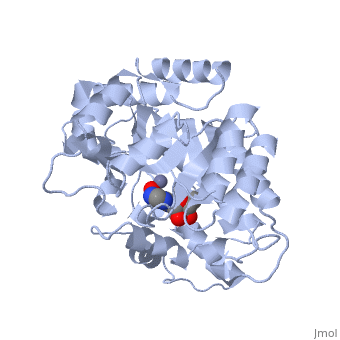User:Ann Taylor/Sandbox Adenosine Deaminase
From Proteopedia
| |||||||||
| 2ada, resolution 2.40Å (default scene) | |||||||||
|---|---|---|---|---|---|---|---|---|---|
| Ligands: | HPR, ZN | ||||||||
| Activity: | Adenosine deaminase, with EC number 3.5.4.4 | ||||||||
| |||||||||
| |||||||||
| Resources: | FirstGlance, OCA, RCSB, PDBsum | ||||||||
| Coordinates: | save as pdb, mmCIF, xml | ||||||||
ADENOSINE DEAMINASE
Adenosine deaminase is involved in the degradation of purine nucleotides. It is especially active in lympocytes, and mutation of adenosine deaminase results in severe immunodeficiency. Adenosine deaminase contains an eight stranded parallel alpha/beta barrel with the active site in a deep pocket at the beta-barrel COOH-terminal end. [1] The active site contains a zinc cofactor, which coordinates to the 6-hydroxyl of the transition state analogue, 6-hydroxyl, 1,6-dihydropurine ribonucleoside. The zinc is coordinated to three histidine residues and an aspartic acid residue.
The transition state analogue held in place mostly by polar interactions. The ribose group is close to the opening of the pocket, with the purine portion deeper in the pocket, close to the zinc. Nine hydrogen bonds stabilize the transition state-enzyme complex.
ADA is very stereoselective for the 6R isomer. This specificity is due to the location of the catalytic zinc, Asp295 and His 238. Interestingly, one face of the purine ring is exposed to polar groups and zinc, while the other face is only exposed to nonpolar residues. The proposed catalytic mechanism has Asp295 act as a general base, while the zinc acts as an electrophile to activate the water molecule. His 238 orients the water and stabilizes the charge of the attacking hydroxide. The protonated Glu217 or the water hydrogen bonded to it could donate or share a proton with the N1 of the substrate.


